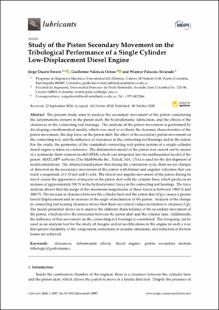Study of the piston secondary movement on the tribological performance of a single cylinder low-displacement diesel engine
...
Duarte Forero, Jorge | 2020-10-30
The present study aims to analyze the secondary movement of the piston considering the deformations present in the piston skirt, the hydrodynamic lubrication, and the effects of the clearances in the connecting rod bearings. The analysis of the piston movement is performed by developing a mathematical model, which was used to evaluate the dynamic characteristics of the piston movement, the slap force on the piston skirt, the effect of the secondary piston movement on the connecting rod, and the influence of clearances in the connecting rod bearings and in the piston. For the study, the geometric of the crankshaft-connecting rod–piston system of a single-cylinder diesel engine is taken as a reference. The deformation model of the piston was carried out by means of a symmetric finite element model (FEM), which was integrated into the mathematical model of the piston. MATLAB® software (The MathWorks Inc., Natick, MA, USA) is used for the development of model simulations. The obtained results show that during the combustion cycle, there are six changes of direction in the secondary movement of the piston with lateral and angular velocities that can reach a magnitude of 0.13 m/s and 4 rad/s. The lateral and angular movement of the piston during its travel causes the appearance of impacts on the piston skirt with the cylinder liner, which produces an increase of approximately 500 N in the hydrodynamic forces in the connecting rod bearings. The force analysis shows that the range of the maximum magnitudes of these forces is between 1900 N and 3480 N. The increase in clearance between the cylinder liner and the piston skirt (Cpc) causes a greater lateral displacement and an increase in the angle of inclination of the piston. Analysis of the change in connecting rod bearing clearance shows that there are critical values in relation to clearance Cpc. The model presented allows us to analyze the different characteristics of the secondary movement of the piston, which involve the interaction between the piston skirt and the cylinder liner. Additionally, the influence of this movement on the connecting rod bearings is considered. The foregoing can be used as an analysis tool for the study of designs and/or modifications in the engine in such a way that greater durability of the components, reductions in acoustic emissions, and reduction in friction losses are achieved. View Full-Text
LEER










